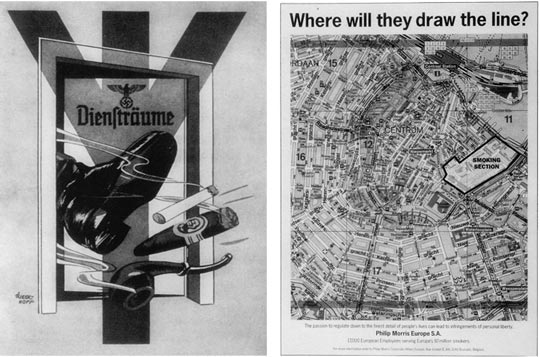
This Article From Issue
November-December 1999
Volume 87, Number 6
DOI: 10.1511/1999.42.0
The Nazi War on Cancer. Robert N. Proctor. 365 pp. Princeton University Press, 1999. $29.95.
In this fascinating, substantial study of cancer and lifestyle in Nazi Germany, Robert N. Proctor makes the startling discovery that the link between smoking and lung cancer was not first established by Anglo-American researchers in the 1950s but by German scientists working in the Nazi period. That Franz H. Müller's 1939 epidemiological study, which Proctor considers to be "an exquisite piece of scholarship,"or the "astonishingly sophisticated" 1943 analysis by Eberhard Schairer and Erich Schöninger, have been almost completely forgotten (indeed Müller and Schöninger have disappeared from the historical record) is not completely surprising given postwar suspicions of the value of German science pursued during the Nazi years. This shorthand leads Proctor to make the useful and distressing point that knowledge about Nazi affiliations does not make it easier to distinguish good from bad science. The fact is that Nazi doctors were "involved in work that we, today, might regard as 'progressive' or even socially responsible." But Proctor is primarily interested in understanding why the link between smoking and cancer was demonstrated, and the first 20th-century war against cancer was waged, under Nazi auspices in the first place. The answers he comes up with amount to a major reconsideration of the modern politics of public health and their primacy in German fascism.

From The Nazi War on Cancer.
Both cancer and the war on cancer were distinctively modern creatures. Although Proctor does not emphasize the theme of modernity, he argues that Germany had at the beginning of the 20th century one of the highest cancer rates in the world. This was so because Germans enjoyed better medical care and thus lived longer and because so many pursued an urban lifestyle that included lots of cigarettes and plenty of beer and schnapps. Occupational hazards made sectors of Germany's industrialized workforce susceptible to cancers as well. At the same time, the recognition that "lifestyle degradations were behind the increase" in cancer rates led to the conviction that "lifestyle changes could reverse the trend." To envision a population as a site for therapeutic intervention was distinctively modern. Although the Nazis were hardly the first or the only group to counsel preventive measures, their conception of the German Volkskörper, or people's body, and their obsession with its long-term health, made them particularly eager to manage public health even if it meant making unprecedented public excursions into private spheres.

From The Nazi War on Cancer.
Indeed, by thinking in biological terms, the Nazis recast politics in an exceptionally vivid and active way. In their view, the German population was mortally threatened in the absence of emergency measures. By the same token, radical surgery and sustained biological cleansing would ensure that Germany would survive and flourish in the fierce international struggles in which World War I had been only the first installment. Biology, in other words, appeared to provide Germany, a loser in the war, with highly useful technologies of mobility.
The war on cancer also fit well with the Nazi notion that national health "could be restored by avoiding exposure to rare but powerful agents corroding the German Volkskörper." The Nazis regarded Jews and the cancer to which they were often and perniciously compared as dangerous but basically exogenous perils that could be managed and even eradicated if there was sufficient political will. The Weimar Republic was a monstrous historical failure in the fascist perspective precisely because its fractured democratic system could not mobilize the political authority to combat the mortal threats facing Germany in the 20th century. Like so many other perils that the Nazis identified, cancer appeared to be "a political disease, requiring political solutions."

From The Nazi War on Cancer.
The focus on cancer gives Proctor a broad view of the body politics at the heart of Nazism. The battle metaphors and cleansing, detoxifying aims of the war on cancer, of course, complemented the single-minded effort to rid Germany of Jews and finally to get rid of the Jews altogether. They also corresponded to elaborate policies to sterilize Germans with purported genetic disabilities. But purification also meant improving the lifestyle of productive non-Jewish Germans. The Nazis waged prominent campaigns against alcohol and smoking and urged Germans to eat more whole-grain bread and foods high in vitamins and fiber. Nonetheless, as Proctor insightfully points out, what at first glance looked like a familiar campaign to educate the public was in fact the mobilization of private bodies to public ends. "Enlightenment in the Nazi era was not something you yourself strived to attain," Proctor writes, "but rather something you did to other people or other people did to you." In order to ensure the long-term health of its genes, Nazi "Germany becomes the most X-rayed nation in the world, a nation obsessed with tracking, diagnosing, registering, grading, and selecting…. At the Nuremberg party congress of September 1938, for example, assembled dignitaries and the public all lined up to have themselves X-rayed." A year later, "the entire adult population of Mecklenburg and Pomerania—everyone aged sixteen and over, roughly 650,000 people—received a chest X-ray … thanks to the efforts of the 'SS X-ray battalion' (Röntgenreihenbildnertruppeder SS)."

From The Nazi War on Cancer.
"The Nazi campaign against tobacco and the 'whole-grain bread operation,'" Proctor concludes, "are, in some sense, as fascist as the yellow stars and the death camps." They highlight the degree to which the Nazis sought to create a "secure and sanitary utopia" and as a result enjoyed broad support. By making this compelling argument, Proctor demonstrates that fascism was a much more subtle and seductive phenomenon than we commonly imagine. At each point, however, Proctor is extremely careful to indicate that the Nazi administration of German health was but one element in a murderous racialized view of the world. The Nazis fought the war on cancer not least because their politics was premised on the possibility of segregating and eradicating what was racially and genetically alien. Moreover, the stress was always on the collective rather than the individual so that general health often obscured particular indifference. Declining disability pensions in the face of an expanding workforce, for example, revealed that "Nazi leaders wanted a healthy workforce, but they were not always willing to help an injured worker." For Germans to become sick or injured invited the scrutiny of state authorities and could become a death sentence if there were any doubts about their "racial fitness."
In Proctor's skillful hands, the war on cancer provides a fascinating view of the biological basis of Nazi public policy and the applied bias of Nazi science. Proctor's examples are vivid and his analysis incisive; precisely because of the congenial mix of the specific and the abstract, The Nazi War on Cancer stands out as a major contribution to the study of fascism and will undoubtedly—and deservedly—become a standard item on reading lists in 20th-century history. It is unfortunate, therefore, that Proctor does not spend a little more time reflecting on the implications of his story. He rightly stresses the different fates that awaited non-Jewish Germans and Jewish Germans, but at the same time indicates that healthy Germans were not necessarily happy Germans. If, in the Nazi's ideal world, as Proctor notes, "workers would work long and hard and then die—saving for the Volksgemeinschaft the financial burden of the elderly and 'unproductive' infirm," would "racially pure" Germans become the subjects of exterminatory wars on illness and old age? If so, what does this say about the centrality of racial categories in the way we think about Nazism? Moreover, Proctor juxtaposes the Nazi war on cancer with our own contemporary anxieties about the disease and expectations for a more robust federal role in combating it, but does not offer satisfying comparisons and contrasts. He flirts with the reader when he observes that anti-antitobacco campaigns "play the Nazi card"; the substance of his analysis and the judiciousness of his judgment leave readers expecting more. Nonetheless, what they have received in this remarkable book is ample and outstanding.
American Scientist Comments and Discussion
To discuss our articles or comment on them, please share them and tag American Scientist on social media platforms. Here are links to our profiles on Twitter, Facebook, and LinkedIn.
If we re-share your post, we will moderate comments/discussion following our comments policy.